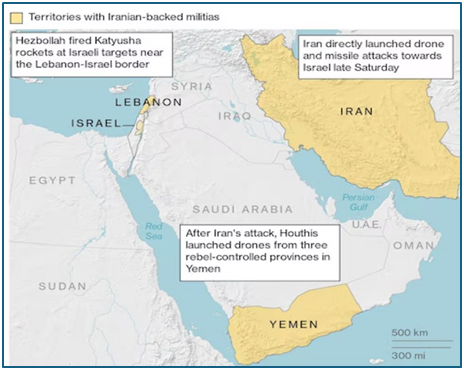Why in news?
On April 14, Iran launched hundreds of drones and missiles towards Israel. This attack was in retaliation for an Israeli attack on its consulate that occurred in Damascus, Syria, two weeks ago. Several senior Iranian generals were killed and Iran had vowed to respond.
What’s in today’s article?
- Iran’s attack on Israel
- India’s stand in Iran-Israel tension
- What does India’s approach on recent Iran-Israel tension signify?
Iran’s attack on Israel

- While Israel is not believed to have suffered any major damage early on, Iran warned that a military move from Israel would be met with a much larger response.
India’s stand in Iran-Israel tension
- India called for de-escalation in the aftermath of Iran’s retaliatory strike against Israel.
- This approach is in contrast to India’s instant expression of solidarity with Israel at the highest political level immediately after the October 7 terror attack by Hamas.
What does India’s approach on recent Iran-Israel tension signify?
- Difference between terrorism perpetrated by non-state actors and direct confrontation between two states
- India’s call to show restraint in the region highlights the contrast between dealing with terrorism from a non-government group and managing a conflict between two big countries with a history of rivalry.
- Delhi has a lot at stake in its relationships with both Tehran and Tel Aviv, and it's never been about picking one over the other.
- If India was seen as taking Israel’s side on October 7 (Hamas attack), its position today urging restraint will be viewed as balanced and in favour of regional peace.
- Complexity of the region’s politics
- India’s call for de-escalation between Israel and Iran is about recognising the complexity of the region’s politics.
- Inter-state and intra-state conflicts in the Middle East are deep and pervasive.
- India will have to forever balance its engagement with key regional actors — Egypt, Iran, Israel, Qatar, Turkey, Saudi Arabia, and the UAE.
- Orientation and interests of these countries are different and often in conflict.
- Shift in India’s approach towards this region
- In the past, India’s regional policy was framed in terms of contradictions between the West and the Middle East.
- E.g., India’s steps to manage the fallout of US-Iran tensions.
- Today, Delhi pays attention to the region’s internal contradictions.
- E.g., India’s stand on Iran – Israel issue, Israel-Palestine issue etc.
- Religion can’t be the dominant factor in dealing with the Middle East
- India’s call for de-escalation also underlines that religion and associated vote-bank politics can’t be the dominant factor in dealing with the Middle East.
- India’s response must be based on the merits of the issue at hand.
- India’s expanding footprints in the Middle East
- India’s interests in the region are no longer limited to oil imports and labour exports.
- The Gulf Arab states — especially Saudi Arabia and the UAE— have emerged as major economic and political partners for India.
- Partnerships with Gulf Arab countries go beyond just two-way relationships and now have a broader impact across the Indian Ocean region.
- These partnerships are crucial for making the India Middle East Europe Corridor (IMEC) a reality, which is currently a top priority for India's trans-regional agenda.
Conclusion
The Middle East is a demanding region and dealing with it is not for the simple-minded or the faint-hearted. As a large neighbour with growing stakes in the Middle East, Delhi is fast learning to navigate the region’s unending conflict.










